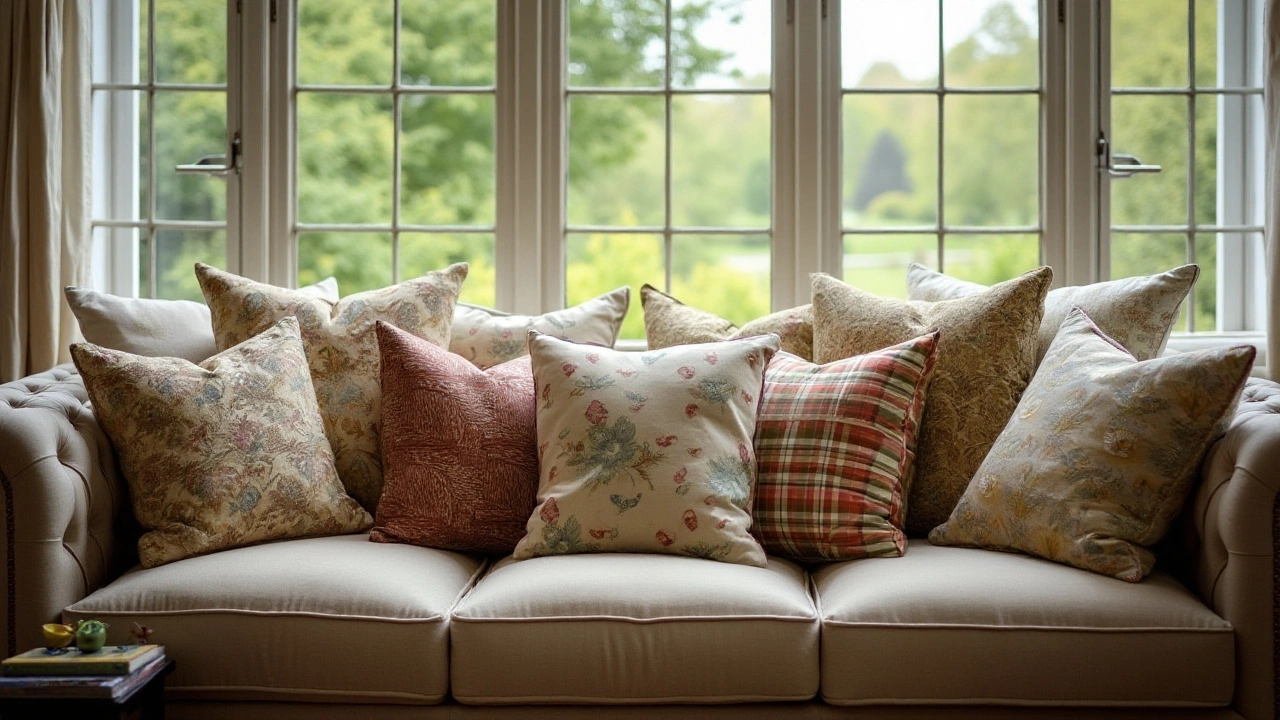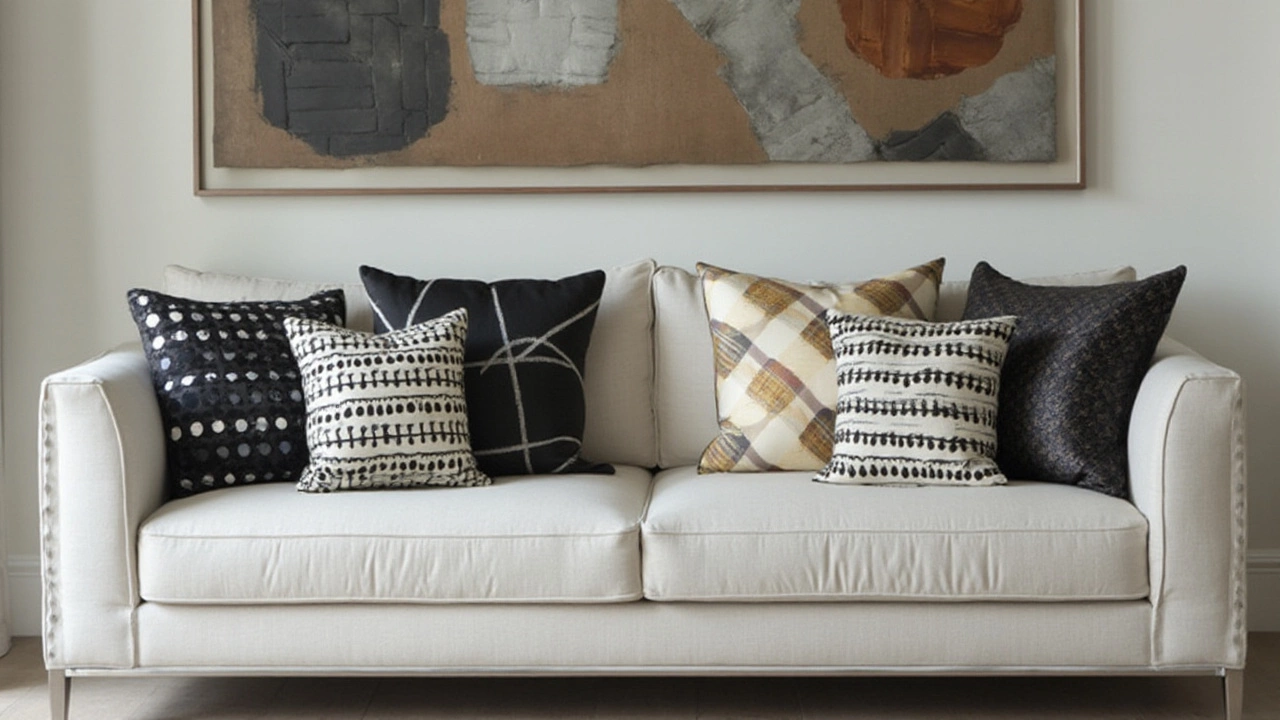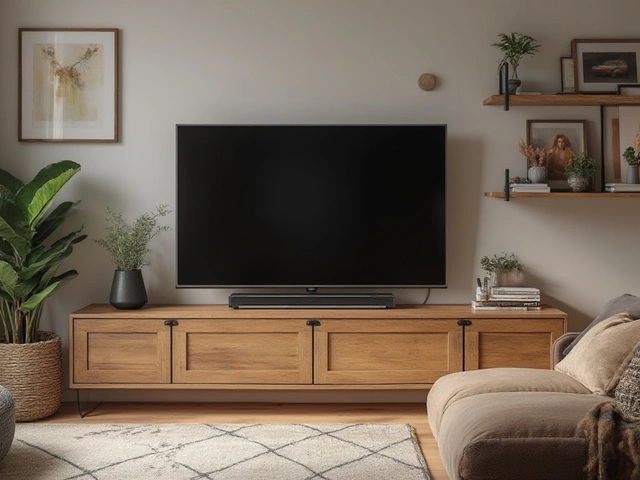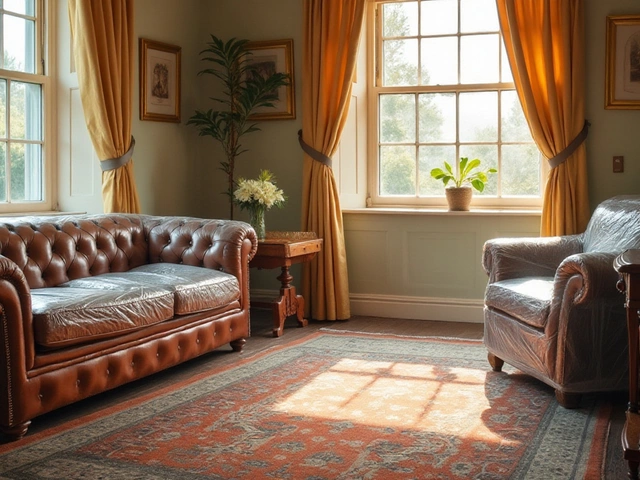 11
Nov,2024
11
Nov,2024
When it comes to home decor, the number of cushions on your sofa plays a crucial role in defining the aesthetic and comfort level of your living space. Whether you love a minimalistic look or prefer a lush, cozy vibe, the cushion configuration can make or break your sofa setup.
Understanding the balance between too few and too many cushions is key. Too little, and your sofa might look bare and uninviting; too many, and you could end up with a cluttered mess that's more frustrating than functional.
In this guide, we'll delve into how to choose the right number of cushions based on your sofa's size, your living room style, and your personal comfort needs. We're here to help you create a seating area that not only looks great but feels just right every time you settle in.
- Understanding Cushion Functionality
- Balancing Aesthetics and Comfort
- Sofa Size and Cushion Quantity
- Mixing and Matching Cushion Styles
- Practical Tips for Arrangement
- Mistakes to Avoid
Understanding Cushion Functionality
When selecting cushions for a sofa, it is not just about looks; it's also about how they enhance the comfort and usability of your seating. Cushions serve multiple purposes, from providing lumbar support to adding a splash of color to plain upholstery. Understanding their function can greatly influence your choice of cushions. In most cases, the primary role of a cushion is to offer comfort. They make any seating arrangement more inviting and comfortable by softening the surfaces against which you lean or sit. A well-placed cushion can alleviate back strain during a long lazy afternoon or a social gathering, ensuring your guests are as comfortable as possible for as long as possible.
Cushions also act as versatile design elements that allow you to switch up the decor with ease. Switching out a set of plain cellular-designed ones for a bold color or intricate patterns can instantly shift the look of an entire room without much expense. This flexibility makes cushions invaluable in seasonal or thematic room redesigns and upgrades. On a practical level, they also help protect your sofa sets from wear and tear, acting like buffers against spills and scuffs. Depending on the cushion's material, they may also contribute to temperature regulation within the room, insulating against cold drafts in the winter or offering a crisp surface in the summer.
Beyond aesthetics and comfort, cushions can serve a specific role in enhancing the health benefits of your seating. According to a statement from Laura Ashley Interiors, "adding specialized support cushions can help maintain proper posture, reducing the risk of muscle tension and discomfort." Designers recommend selecting cushions with memory foam or ergonomic shapes if long hours on the sofa are typical in your household. These can be particularly beneficial in work-from-home settings or if you indulge in long movie marathons on weekends.
Finally, the functionality of a cushion extends to facilitating better seating arrangements. They can effectively divide larger sofas into intimate nooks, creating private spaces in expansive living areas. With cushions, you can guide people into certain arrangements intuitively by providing visual cues on where one set ends and another begins. This is especially useful in open-plan homes where distinct seating zones enhance both the room's aesthetics and its practical usage. Armed with this understanding, choosing the right cushions for your sofa becomes less about guesswork and more about an informed decision that harmonizes comfort, style, and practicality.
Balancing Aesthetics and Comfort
When arranging cushions on your sofa, it's crucial to strike a fine balance between aesthetics and comfort. This balance can affect not only the look of your living room but also how inviting your space feels to you and your guests. The artful arrangement of sofa cushions is akin to dressing for an occasion - too much, too little, or mismatched choices can alter the whole ensemble. But when done right, it's the perfect blend of order and creativity, lending both visual appeal and coziness to your living area.
Start by considering the sofa itself. A larger sectional might comfortably showcase an array of cushions, creating a plush, inviting look without losing style points. On the other hand, a smaller couch might look cramped with too many cushions, so fewer, well-chosen options will maintain a sleek and open appearance. According to an interior designer Adrianne Smith,
‘Cushions should enhance the decor and inspire comfort, not overwhelm the functionality of the space.’Achieving that delicate balance means understanding not only the dimensions of your seating but also the frequency and ways it is used.
Think about choosing cushion colors and patterns that complement your existing decor. This step requires considering the hues of surrounding furniture, walls, and other accessories in the space. Some might start with two primary colors and add a third as an accent. Keep in mind, though, that while bold patterns can jazz up a neutral sofa, too much playfulness might clash with a tranquil themed room. Yet, sometimes juxtaposing different textures and prints can craft a delightful eclectic look that invites relaxation and conversation.
Another layer to consider is comfort, which is inherently subjective. Imagine yourself sinking back after a long day, and think what arrangement of cushions will allow you to completely unwind. A setup that seems perfect aesthetically may not fulfill the need for pure indulgence in relaxation. Thus, it's wise to test different arrangements, sitting and lying on your sofa as envisioned in your daily use, ensuring nothing looks or feels out of place. Consider cushion sizes as well. Larger, fluffier options provide fantastic back support, while smaller ones might serve better as armrest supplements or decorative flourishes.
Don't forget the maintenance aspect. The practicality of your cushion arrangements will also hinge on how easy they are to care for. Can you quickly remove the covers for washing? Are they materials that might quickly lose their charm after a few washes? These questions can lead to choosing stain-resistant fabrics or slipcovers, ensuring your setup remains visually delightful through coffee spills and general living wear and tear, keeping both aesthetic allure and practical coziness intact.

Sofa Size and Cushion Quantity
When it comes to selecting the right cushions for your sofa, the size of your seating arrangement plays a pivotal role. The physical dimensions of your sofa directly influence not only how many cushions you should place but also the overall comfort and visual appeal. A standard-sized sofa, often referred to as a three-seater, typically accommodates between four to five cushions. This configuration provides enough cushioning for a pleasant seating experience, while still allowing each cushion to shine as an element of the room's decor. However, this number can be flexible depending on personal preference and the specific style you wish to achieve.
In larger spaces with sectional sofas or L-shaped configurations, an increased cushion quantity can enhance symmetry and balance. For these expansive seating arrangements, aiming for an array of about seven to ten cushions is ideal. Such cushion variety not only accentuates the generous dimensions of the sofa but also invites guests and family members to enjoy a cozy and welcoming setting. The use of more cushions ensures that the corners and angles of the sectional are well-utilized, providing additional seating support and decorative highlights.
Conversely, smaller sofas, like loveseats or two-seaters, benefit from a more restrained number of cushions. Typically, two to three carefully chosen cushions work best, providing ample comfort without overwhelming the space. Bringing attention to this cozy setup, a mix of textures and colors can create an inviting atmosphere without making the seating area seem overcrowded. Remember that every cushion carries both a visual and practical purpose, so varying the sizes, such as mixing 20-inch cushions with smaller 16-inch ones, can add depth while maintaining proportionality.
It's also interesting to note how expert interior designers approach this aspect. As renowned interior designer Nate Berkus once remarked,
"Finding the right balance in cushion arrangements is about understanding the space your sofa occupies and what you hope to convey through your decor."His insights reflect the intricate dance between enhancing personal style and accommodating practical spatial elements. Paying attention to how cushions are arranged can reflect your personality while adapting to functional needs, providing a feeling of completeness to your living area.
For those who enjoy experimenting with home decor, remember there's no strict rulebook when it comes to cushion placement. It's about finding the harmony that resonates with you and aligns with the scale of your furniture. If you're looking to bring in pops of color or a unifying pattern, cushions become the perfect accessory to express seasonal themes or current trends. This personalization is limited only by the size and style of your sofa, offering abundant room for creativity and expression while maintaining a refined and coherent decor story.
Mixing and Matching Cushion Styles
Mixing and matching cushions can be an art form that brings your living space to life with texture and color. By thoughtfully selecting and arranging different cushion styles, you can highlight the personality of your home. Start by considering the color palette of your room. Choosing cushions that complement or contrast these colors can enhance the visual appeal of not just the sofa, but the entire room. Be bold with your choices; a cushion might be a small addition, but it can pack a vibrant punch.
For a balanced look, mix solids with patterns, and consider a variety of textures such as velvet, cotton, or linen. Patterns should be a reflection of your personal taste; they can range from geometric designs to florals or even abstract art. The key is in creating harmony. As interior designer Ilse Crawford once said,
"Beauty should be the consequence of utility."This quote perfectly encapsulates the idea that functionality and aesthetics should coexist, especially when it comes to cushions.
Don't shy away from mixing different sizes and shapes. Rectangular cushions paired with square ones can add depth and interest, while circular or bolster cushions offer a quirky touch. Think about scale; larger sofas can handle larger cushions, whereas smaller sofas benefit from petite and less overwhelming choices. A pro tip is to use a mix of odd numbers, often three or five cushions in various sizes, which tends to look visually appealing.
Consider also the style era you are inspired by. If you love mid-century modern decor, go for bright pops of color and sleek textures. For a more traditional setup, opt for rich fabrics like silk and intricate embroidery. Alternatively, an eclectic style invites any mix, which can be particularly liberating if you cherish a variety of patterns collected over time. Dive into your creative side, and let each cushion serve as a tiny canvas for your stylistic expression.
Creating Themes
When experimenting with sofa sets, creating themes around your cushions can be a delightful endeavor. Seasons offer a simple thematic guideline; warm tones and textures for fall and winter, bright and airy options for spring and summer. Themes can extend to holiday motifs or a reflection of your travels—imported textiles or hand-crafted designs often tell a story.
An important aspect is to ensure cushions tie together not just with the sofa, but with other elements in the room, such as curtains, wall art, or a cherished area rug. This doesn't mean everything should match, quite the opposite: complements are more engaging. Imagine a seafoam green cushion against a terracotta backdrop – the juxtaposition can be stunning. But remember, while experimenting, it's good to have a rule of thumb or a guiding principle to maintain a degree of order amidst the creative chaos.

Practical Tips for Arrangement
Arranging cushions on your sofa is an art that combines creativity with a keen eye for balance. Walking into a room and seeing a carefully curated sofa immediately sets the atmosphere, whether it's for relaxing or socializing. One way to start is by considering the color palette of your room. Selecting cushions in varying shades can create a cohesive look that ties the room together. For those who enjoy lively spaces, mixing patterns can bring a dynamic feel. However, sticking to two or three colors is usually enough to avoid a tired look.
There is a golden rule in cushion arrangement: work in odd numbers. Three or five cushions tend to look more appealing than an even number. This tip works because odd numbers create a focal point. Arranging them diagonally can introduce some movement, capturing the eye as it naturally scans through the room. If your sofa set is quite deep, you might have room for a full layer of cushions in front and behind. However, avoid overfilling; legs need space too. Swap cushions seasonally. This simple trick can freshen up your space without overhauling the whole setup.
Mixing Textures and Sizes
In addition to color, texture plays a key role in arrangement. Pairing a soft velvet cushion with a chunky knit can add depth and comfort. Different sizes offer flexibility; large ones as a base and smaller ones for accent add a structured look. Using variations helps each cushion stand out, making the arrangement appear intentional, not arbitrary. A practical setup often includes one large lumbar cushion, which can serve as a back support, flanked by square pillows for a neat appearance. Remember, practical means both aesthetic and functional, especially in shared spaces where cushions are frequently in use.
"A few well-chosen cushions can utterly transform a plain sofa into a statement piece," advises interior designer Emily Henderson. "It's all about choosing what complements your room's vibe and functionality needs."
If you're unsure where to start your cushion experimenting, try the classic symmetrical style: one cushion at each end of the sofa set and one in the middle, slightly larger in size or with a bold pattern. It's a dependable layout that effortlessly adds sophistication. When the cushions complement each other despite varied colors, patterns, or sizes, they appear to belong together.
Seasonal and Personal Touches
Seasons can inspire different layout styles, giving your living space a fresh look different times of the year. Bright florals in spring, airy linens in summer, rich, warm tones in autumn, and cozy wools in winter all allow you to transition within your existing decor. Personalize your sofa further by using cushions that tell a story—perhaps a travel-themed cushion that's a reminder of a memorable vacation. Carefully chosen additions make your space homey and inviting.
Finally, an often overlooked but clever tip is mindfulness. If daily tidying isn't your thing, aim for cushions that look effortlessly thrown together. This creates a relaxed atmosphere, which is often just what one needs after a long day. No matter your approach, the secret is in trying different configurations until you find the one that brings your living space to life.
Mistakes to Avoid
Choosing the right number of cushions for your sofa isn't just about aesthetics—it's about function and usability too. One common mistake that many people make is piling on too many cushions, which can transform your inviting sofa into an impenetrable wall of fabric. This not only hinders comfort, causing irritation when it takes too long just to find a spot to sit, but it can also detract from the overall visual appeal of your sofa set. When cushions start to overshadow the sofa itself, you might lose the elegance of the sofa's design and potentially create a chaotic look in your living space.
On the opposite end of the spectrum, having too few cushions can make your sofa appear bare and unwelcoming. This often results in an unbalanced decor harmony in your living room, as cushions play a key role in bringing warmth and texture to the environment. Not considering the primary use of your sofa can also lead to poor cushion choices. If your family loves to lounge and spend time there, you might prefer softer, plush options, whereas a more formal setup might warrant decorative, structured cushions.
Another significant misstep is ignoring the style and color coordination of the cushions with the rest of your living room. Incorporating sofa set aesthetics with your existing decor scheme is vital; failing to do so could make your sofa stand out in an unpleasant way, disrupting the room's flow. It's essential to consider the colors, fabrics, and patterns of your cushions in this regard. This attention to detail can significantly elevate the mood and look of your interior space.
"A well-balanced cushion arrangement can not only add to the decor but can enhance the functionality of a room," notes interior design expert, Anna Smith.
Additionally, forgetting about practicality is another pitfall. Depending on your household habits, selecting cushions that are easy to clean and maintain can save time and energy. If you have kids or pets, choosing robust, washable covers will help keep your home looking immaculate. Investing in cushions that require excessive maintenance can become an unnecessary hassle over time, more so than people initially realize.
Avoiding these mistakes involves a mindful approach to both design and lifestyle. Keep in mind not to follow trends blindly, as what works beautifully in a magazine might not necessarily suit your personal space dynamics. Trust your instincts and allow your unique style to guide your cushion choices, always aiming for that harmonious blend of beauty and functionality.




